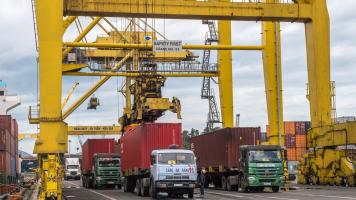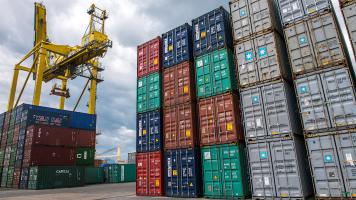
Trade integration in Asia and the Pacific is now comparable to that of the European Union plus the United Kingdom. Photo credit: ADB.
Robust trade networks, solid financial linkages, and substantial movement of people across Asia credited for Southeast Asia's lead in regional integration.
Southeast Asia continues to lead regional integration in Asia and the Pacific, with subregional programs, including the Brunei Darussalam–Indonesia–Malaysia–Philippines East ASEAN Growth Area (BIMP-EAGA), integrating more deeply, according to a new report from the Asian Development Bank (ADB).
“Cooperation through trade facilitation, along with the development of transport and economic corridors, has helped advance integration across the region,” said the report.
According to ADB’s new Regional Integration Index, Southeast Asia is the most integrated across all but the foreign direct investment (FDI) dimension. This is due to its robust trade networks, solid financial linkages, and substantial movement of people across the Asian region. The index looks at four dimensions: trade, FDI, finance, and movement of people (i.e., migration, remittances, and tourism).
Rising global clout
The report said economic integration has been pivotal in Asia’s growth and rapidly rising global clout over the past 2 decades. Analysis shows trade integration in the region is now comparable to that of the European Union (EU) plus the United Kingdom (UK). In the report, Asia refers to the 49 members of ADB in Asia and the Pacific, which include Australia, Japan, and New Zealand in addition to 46 developing economies.
Over the past 2 decades, Asia has significantly tightened its regional economic integration, surpassing other regions in FDIs and the movement of people.
Asia led in trade in goods and services in 2005 but came in a close second to the EU plus UK in 2023. Between 2005 and 2023, Asia led in trade integration until 2015, which coincides with a global economic slowdown. Since then, EU plus UK have led in trade integration, with Asia following closely behind.
The EU plus UK continued to lead in financial integration, followed closely by Asia. Latin America has advanced but still remains behind in financial integration.
Asia’s regional integration in FDI has also advanced significantly, although less than trade integration. Migration, remittances, and tourism—or “movement of people”—have remained steady. Financial integration has been the lowest, being lower than in trade, investment, and movement of people, and has lagged behind that of the EU and UK.
Africa remains the least integrated in terms of trade, FDI, and movement of people.
Subregional groupings
In Asia and the Pacific, East Asia, along with Pacific and Oceania, also showed substantial integration. East Asia has strong trade and investment flows and is well-integrated financially. The Pacific and Oceania benefits from active trade and people traveling and working in other Asian economies.
In contrast, Central Asia and South Asia recorded the lowest integration indexes. These subregions are challenged by underdeveloped infrastructure and smaller markets—which limit economic diversification.
Central Asia’s landlocked geography and reliance on a limited range of export commodities reduce natural opportunities for integration. While South Asia is showing some progress, it still lags as development remains uneven across the subregion, particularly in terms of trade, openness to FDI, and advancements in financial markets.
Southeast Asia leads with greater integration in trade, finance, and movement of people, while East Asia is strong in FDI and movement of people. Pacific and Oceania is well integrated in trade and FDI.
Subregional initiatives
While Asia’s subregions are growing more integrated, there are some differences in integration within subregions and integration of subregions with the rest of the region.
The report finds deeper integration in Southeast Asia’s three subregional programs: BIMP-EAGA, the Greater Mekong Subregion (GMS), and the Indonesia-Malaysia-Thailand Growth Triangle (IMTGT).
Between 2006 and 2022, BIMP-EAGA’s deeper integration was largely driven by infrastructure connectivity, institutional arrangements and technology, and digital connectivity. For instance, lower trade costs and improved liner shipping connectivity contributed to stronger regional linkages. Integration momentum was further sustained by joining regional value chains, improving trade complementarity, and importing intermediate goods.
Intrasubregional integration in the GMS has increased over the past decade due to strong cooperation among its members. While the Central Asia Regional Economic Cooperation (CAREC) program shows more moderate levels of integration, both intrasubregional and intersubregional linkages have gradually increased more consistently since 2020. The South Asia Subregional Economic Cooperation (SASEC) has increasing contact and transactions with other Asian economies.
While GMS is strongly anchored on subregional integration, Central Asian economies have enhanced linkages over time both within and outside the CAREC region, while SASEC economies maintain strong linkages with other Asian economies.
Deepening regional integration between subregional initiative members occurs through various projects and programs. Most subregional initiatives prioritize projects that improve trade and supply chain linkages, transport and infrastructure connectivity, and the movement of people. These are usually included in strategic documents such as the GMS Economic Cooperation Program Strategic Framework 2030, the CAREC 2030 Strategic Framework, the SASEC Vision, and the BIMP-EAGA Vision 2025.
Large investments support these programs, with $34.3 billion and $12.7 billion allotted for transport and energy projects in the CAREC region, and $34.5 billion mobilized to support BIMP-EAGA infrastructure projects.
Beyond these traditional links, subregional initiatives have also begun to sharpen their focus on supporting newer channels of connectivity, such as digital transformation and environmental cooperation initiatives. For instance, GMS developed a Digital Economy Cooperation Initiative in 2022 to promote inclusive digitalization and advance technology use.
This article was first published by BIMP-EAGA on 3 July 2025.

BIMP-EAGA
The Brunei Darussalam–Indonesia–Malaysia–Philippines East ASEAN Growth Area, or BIMP-EAGA, is a cooperation initiative established in 1994 to spur development in remote and less developed areas in the four participating Southeast Asian countries.

